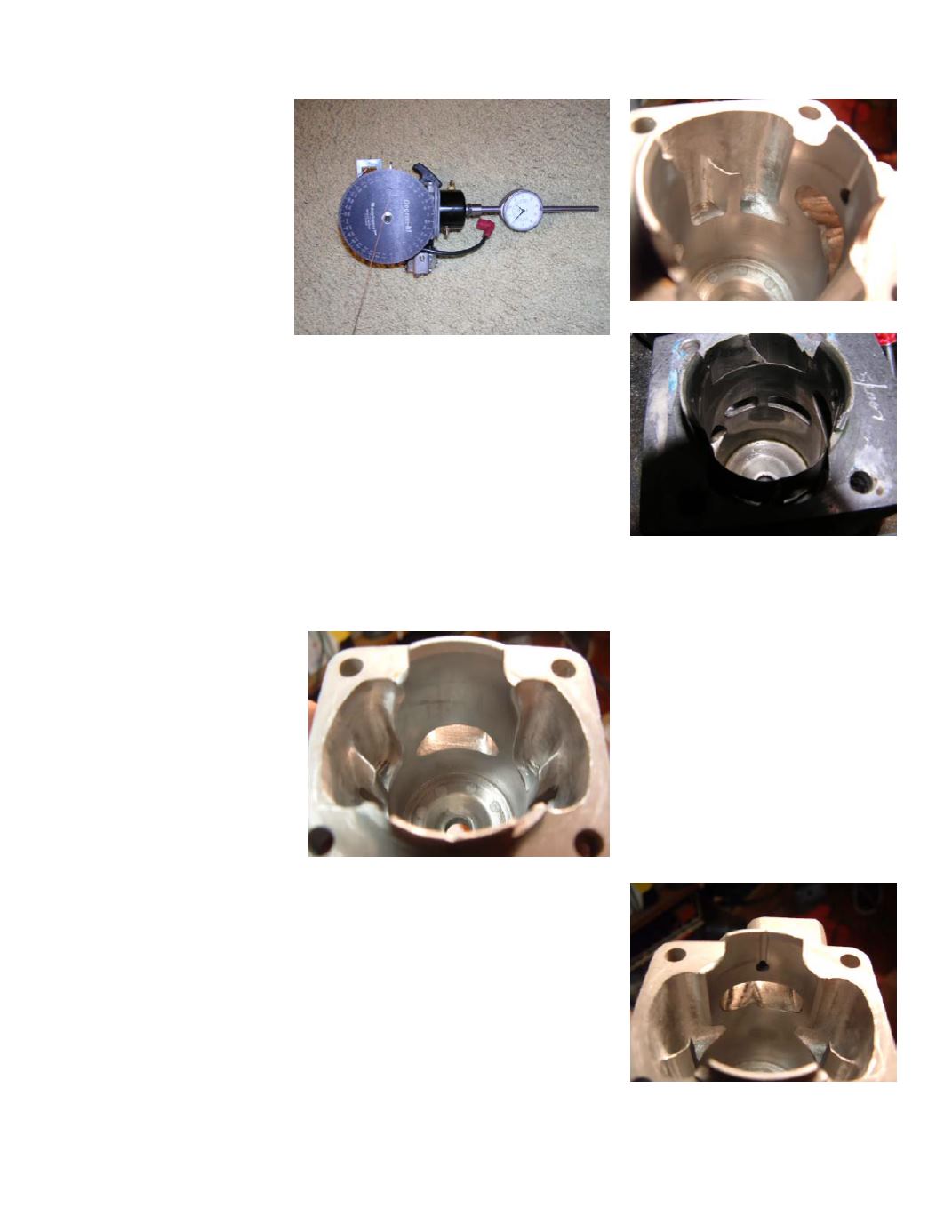
The intake timing can be increased as
well. The easiest way to do this is to cut
the piston skirt on the intake side.
Removing .040” (1 mm) as well as
dropping the cylinder .015” (.38 mm)
with a thin base gasket increases the
intake duration from around 150 degrees
stock to 160 degrees. Intake timings of
170 degrees require cuts on the skirt and
the cylinder base totaling close
to .100” (2.54 mm) total. The bottom
edge of the intake port could be cut the
same amount giving the same timing
result with a stock piston skirt length.
Increasing the intake port height by
cutting its bottom edge will increase the
flow more than cutting the piston.
(Continued on page 8)
PROPWASH
October 2015
7
can be inserted into a port. The
engine is then rotated back so its
width, measured as shown below, is
subtracted on the indicator reading.
The degree wheel reading is the
port opening time.
A spreadsheet can be used to get
the actual piston travel reading for a
particular port opening time. You
need to know the stroke and rod
length. A Zenoah 260 has a 28 mm
stroke and a 50 mm rod length. The
travel can then be read on the dial
indicator after subtracting the
calculated wire dimension. The
exhaust and transfer ports are
measured between the piston crown and the top of the port but the intake port is
measured between the piston skirt and the bottom of the intake port.
Let’s look at the ports of a stock Zenoah. The stock exhaust port opens around 100
degrees after top dead center (ATDC). The total open duration is 160 degrees. That
combined with the port size gives a time area that allows about 2.8 horsepower. The
transfers are oaky, opening 120 degrees ATDC, giving a time area for about 5 1/2
horsepower. The intake port opens around 75 degrees before TDC for a time area that
allows about 5 horsepower. It’s possible to get a reasonable engine of about 5
horsepower by raising the exhaust port so it opens 90 degrees ATDC. That is done by
angling up the port at the cylinder. Nearly .100” (2.54 mm) needs to be taken off and
the wall gets thin. The other easy modification is replacing the paper base gasket with
a .005” (.12 mm) copper gasket. That will bring the squish clearance down from
over .030” (.76 mm) to somewhere between .010” (.25 mm) and .015” (.38 mm). This
also increases the intake timing a little
to 154 degrees duration.
To get to over 6 horsepower,
everything needs to improve. This
section is illustrated with pictures of
engine modifications done by Scott
Schneider. He may not agree with my
numbers or opinions. The exhaust
timing can be raised (carefully) even
more and the port widened at the top.
Widening .080” (2 mm) alone after
raising the port to open 90 degrees
ATDC will give a time area for over 6
horsepower. The timing can be raised
to open as much as 85 degrees ATDC
for even more power with the right pipe. I like a straight exhaust port top, but others
create a gentle arc. Be sure to radius all the port edges to remove burs.
The transfers don’t need to be raised. Raising the transfers too much cuts into the
blow down period. That’s the time between exhaust opening and transfer opening that
lets the cylinder pressure drop enough to let the transfer flow start. The transfers can
be widened, though. The transfer nearest the exhaust can be ground to remove the
angle and the rear transfers can be eyebrowed over the intake port. The rear transfer
passage can be carefully widened for more flow into the eyebrow. The transfer
passage divider can also be shortened. Even though the new time area should allow
10 horsepower, I doubt that the eyebrow area flows as well as a proper transfer design.
Both the Quickdraw and the M&D cast cylinder have deeper rear transfers and, as a
result, develop at least 1 horsepower more than modified Zenoah’s. View the
comparison pictures in the following column.
Degree wheel, wire feeler, and dial indicator on
an engine
Exhaust Port Modifications
Zenoah transfer modifications
M&D Cast Cylinder Transfers
Modified Intake Port


